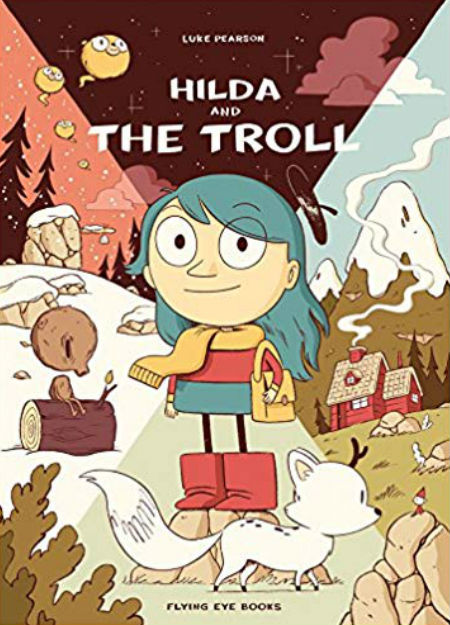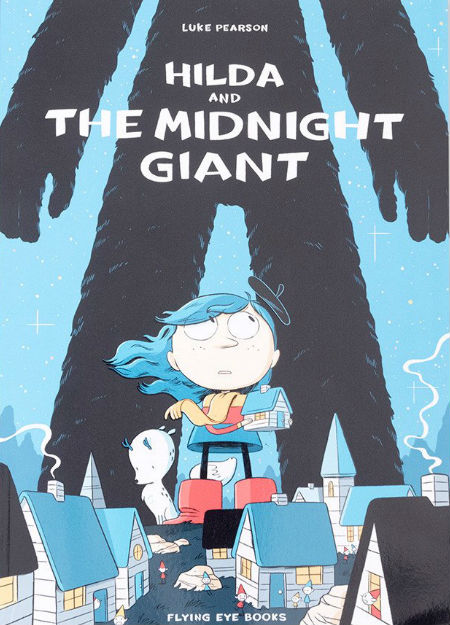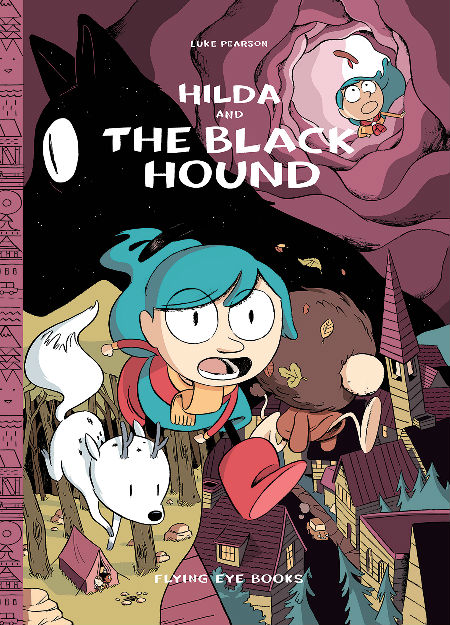
It is a rare thing indeed to stumble across a character, and the world they and similarly-enchanting people and creatures inhabit, that remind you of the very best things you read when you were a child.
If you’re an occasional pop culture nostalgist, someone like me who loves and appreciates the cartoons & comics, music, books and TV of their childhood but is just as firmly-situated, if not more so, in the present such is your love of discovering the new and the different, you’ll fall in love as I did with Hilda, a series of graphic novels by British artist Luke Pearson who is also responsible for storyboarding episodes of the just-finished cartoon series Adventure Time‘s fifth and seventh seasons.
The appeal of Hilda, if you’re a little older than the likely core demographic of Hilda like yours truly, is that evokes the lovely sentiments, quirky sensibilities and lusciously-original world building of comic and book series such as the Moomins, Agaton Sax and Asterix, while still being gloriously and delightfully itself.
Evocative of worlds and characters past most certainly, but no means beholding to or derivative of them, Hilda, the story of an unusually, wonderfully curious and caring young girl in a fantastically magically-real alternate late 20th-century Scandinavia, is idiosyncratically-charming on every level.
It is impossible not to like Hilda a great deal since she embodies so many things that seem to be out of vogue in our more cut-throat, neo-capitalist, end justifies the means world right now.
Not that Hilda is evenly faintly political or polemic; on the contrary there’s a refreshing escapist quality to the series that takes you far away from your troubles and cares while still managing to zero in beautifully on what its like to be a kid, and yes, the mum who constantly worries where her daughter might be even as she gifts her (mostly) with the time, freedom and space to live a wondrously, expansively extraordinary life.

And the life that Hilda leads, whether it’s out in the woodlands where her grandfather built a wood cabin or in the city of Trollberg, is as wondrous as it gets.
That’s thanks in part to Hilda’s inclusive and inquisitive spirit which though possessing the potential for being scared and uncertain like all of us, is far more prone to assuming and living out the best in ways that many of us aspire to but never quite achieve.
Inspired by Scandinavian folklore, Pearson has placed Hilda’s uniquely-adventurous personage into a world inhabited by elf cities, that are, amusingly, only visible to those who are of good heart and have signed the necessary paperwork – they may be small and magical but they have their bureaucracy and it must be obeyed; well, until the kid is save from a mountain made of a giant person and then all bets are off – and migrating fluffy and furry flying dog-like creatures called Woffs and trolls who turn to rock in the daytime (and from which the city takes it name), and sea spirits and wandering giants and … well, you get the idea.
It’s a magically real and Hilda, open to the new, the unusual and the different, and always working on the assumption that something is good before she decides its not – true that doesn’t extend to trolls who are kinda scary until it kind of does – revels in it all becoming friends with pretty much everyone, one of the many qualities her mother, and no doubt dog Twig, love about her.
The thing is, for all her loveliness and sweetness, Hilda never once feels unbearably twee or impossibly, nauseatingly cute; that’s because Pearson imbues the entire series with a down-to-earth realism and sense of authenticity that makes it feel enchantingly real from the word go.
From the simple but evocative image of the cabin that opens the first book, Hilda and the Troll, through the giant-reuniting, elf-militant narrative of Hilda and the Midnight Giant (he’s such lonely and in love everyone) through to the move to Trollberg that fills the last three books, Hilda and the Bird Parade (quirky, amnesic giant bird anyone?), Hilda and the Giant Hound where appearance are definitely deceptive, and Hilda and the Stone Forest where spare-space dwelling Nisse (domestic sprites who inhabit buildings) take you into magically-terrifying realms behind your dresser drawers, Hilda’s is a fully-formed, amazing world you will want to live in for as long as possible, and return to whenever the opportunity permits you.

If you have even a skerrick of the wonder of childhood left percolating in the calcified adult soul you now presumably sport, and you’re longing to let your inner child do their thing unhindered once again, free to indulge imagination, the best of impulses, and unconditional friendship without question, you will adore Hilda.
There is not a moment of this lavishly and vividly-illustrated and wonderfully written series that you won’t have you champing at the bit to go and draw rocks out where the trolls live and woffs fly whimsically overhead, to spend your days becoming friends with a wood man (one of the few times Hilda acts petulantly and with unreasonable assumption only to be proven wrong; the good thing there? She admits, unlike most of us, and move happily on) and help you and your mum find your way home from a maze filled with trolls, good and bad.
It is all the dreams, musings and daydreams of childhood sprung mischievously and charmingly to life, infused with humour and wonder, and a groundedness that makes it all feel very real even as you realise it is not, and don’t care anyway.
Hilda’s world is in many ways quite ordinary in that she has to go to school, observe curfews and deal with other kids who have lost, if they ever had it, extravagantly-expansive view of the world and spend time with her mostly cool mum (who, thankfully, acts like a mum out of love and a genuine sense of wanting her daughter to be the best Hilda she can be) but Pearson weaves the utterly extraordinary through it in such a way that the appearance of all these folkloric creatures feels entirely normal and natural.
Hilda is your ticket to the childhood of yore, or perhaps you’re still there or barely out of it and don’t want to let it go just yet – why let it go at all? Hilda makes a case for keeping that exuberant sense of wonder with you all life long – a gorgeously, visually-lush, imaginatively-unfettered and magically real where kindness and thinking the best of others isn’t out of date or something weak and twee but robust and real, the stuff of everyday adventures that have not forgotten there is magic and connection to be found everywhere if you’re open to it.
Hilda is now an equally-beguiling cartoon series on Netflix.